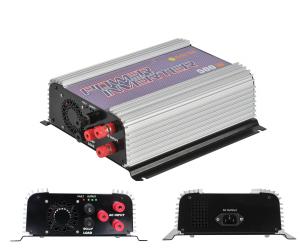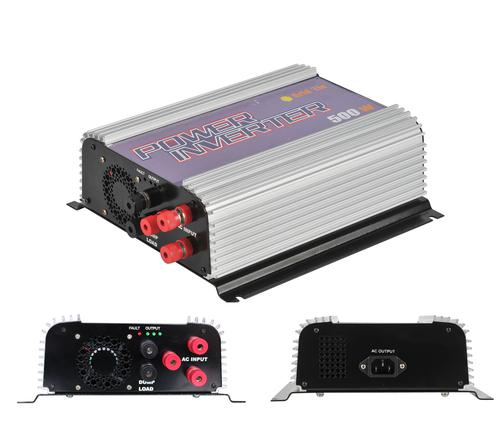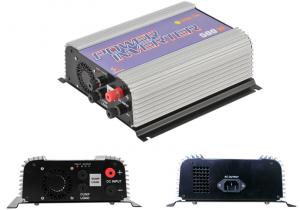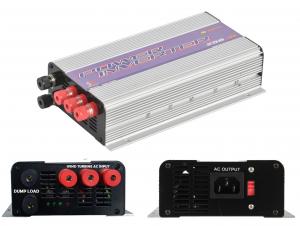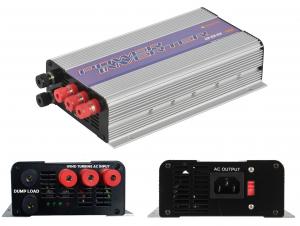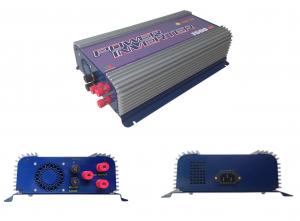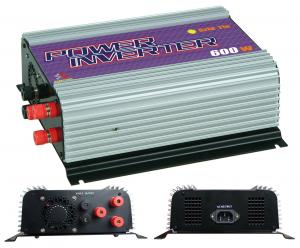SUN-500G-WAL Wind power grid tie inverter/500w
- Loading Port:
- Ningbo
- Payment Terms:
- TT OR LC
- Min Order Qty:
- -
- Supply Capability:
- 1000 kg/month
OKorder Service Pledge
OKorder Financial Service
You Might Also Like
Grid Tie Inverter for Wind Turbine
Model: SUN-500G_WAL
l Build In Rectifier
l Build In Dump Load Controller
l Build In High Wind Protection
Preface
The grid-tie inverter can transfer wind energy from wind generators directly into the home grid using no extra equipment. It can be connected to any outlet (conventional network) in the home. The grid-tie inverter controls the phase and the frequency and voltage of the power generated by the wind generator. It produces a pure sine-wave and matches that of the grid.
This model grid-tie has build in bridge rectifier and dump load controller, it can maintain the rotating speed of the wind turbine and keep the voltage from the wind turbine always at the range of the rated range of the grid tie inverter. It also has a high voltage protection function, when the wind is too big, and the dump load controlling system can’t keep the output voltage from the wind turbine, the controller will disconnect itself from the wind turbine, so it is very safe to be used.
There are 5 terminals on the left side of the inverter, 3 red terminals will be connected to the three phase output from the wind turbine, and 2 black terminals will be connected to dump load resistors.
There are 4 LED indicators, 3 green indicators and 1 red indicator, 3 green LED indicators will start to cycle from left to right when the grid and AC input supply is detected. This indicates the inverter is operating under normal condition. The rate of the cycling is according to how much power is being output from the wind turbine. The bigger the output power is, the faster the rate is. If there is no AC grid detected, the red LED will be on, the inverter will not put out power, this is called “Island Protection”.
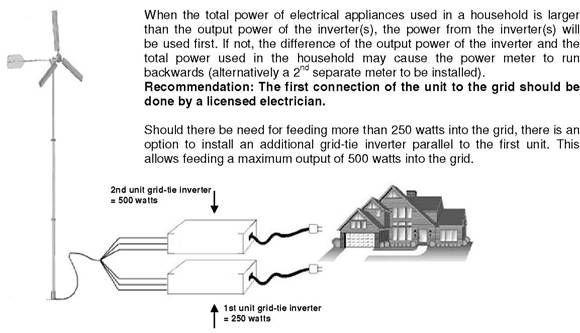
Electrical Specifications:
Model | SUN-500G_WAL | |
Normal AC Output Power | 450W | |
Maximum AC Output Power | 500W | |
AC Output Voltage Range | 110V/230V | 90V ~ 130V / 190V~260V |
AC Output Frequency Range | 46Hz ~ 65Hz | |
Total Harmonic Distortion(THD) | <5% | |
Power Factor | 0.99 | |
DC Input Voltage Range (the test point is at the output of the rectifier) | 22V~60V/10.8-30V | |
Peak Inverter Efficiency | 92% | |
Standby Power consumption | <1.5W | |
Output Current Waveform | Pure Sine-wave | |
MPPT Function | Yes | |
Over Current Protection | Yes | |
Over Temperature Protection | Yes | |
Reverse Polarity Protection | Yes | |
Island Protection | Yes | |
Stackable | Yes | |
| | | |
Mechanical Specifications:
N.W | 4.0kg |
G.W | 4.5Kg |
Dimension | 332mm*265mm*135mm |
Operating Temperature Range
-10 ~ 45 degrees C
- Q: Can a solar inverter be used with different types of solar tracking systems?
- Yes, a solar inverter can be used with different types of solar tracking systems. Solar inverters are designed to convert the direct current (DC) produced by solar panels into alternating current (AC) for use in homes or businesses. They are compatible with various solar tracking systems, including single-axis and dual-axis trackers, as long as the voltage and power ratings of the inverter match the requirements of the specific tracking system.
- Q: What is the role of power factor correction in a solar inverter?
- The role of power factor correction in a solar inverter is to improve the efficiency and performance of the inverter by correcting and optimizing the power factor of the electrical system. By adjusting the phase relationship between voltage and current, power factor correction ensures that the inverter draws and supplies power more effectively, reducing energy losses, improving power quality, and minimizing harmonics in the system. This helps to maximize the overall power output and reliability of the solar inverter, leading to better energy conversion and utilization.
- Q: Can a solar inverter be used in a solar-powered air conditioning system?
- Yes, a solar inverter can be used in a solar-powered air conditioning system. The solar inverter is responsible for converting the DC power generated by solar panels into usable AC power for appliances, including air conditioners. By utilizing a solar inverter, the solar-powered air conditioning system can effectively harness solar energy to cool spaces while minimizing reliance on traditional energy sources.
- Q: How do you calculate the payback period for a solar inverter?
- To calculate the payback period for a solar inverter, you need to determine the initial cost of the inverter and then calculate the annual savings or earnings generated by the inverter. Divide the initial cost by the annual savings to get the payback period, which is the time it takes to recoup the investment through savings or earnings.
- Q: What is the role of transformerless design in a solar inverter?
- The role of transformerless design in a solar inverter is to eliminate the use of a bulky and costly transformer, which helps reduce the overall size, weight, and cost of the inverter. Additionally, a transformerless design allows for higher efficiency and improved performance of the solar inverter.
- Q: Three-phase photovoltaic inverter grid, the use of phase-locked loop is what?
- In addition to the function of converting DC current into alternating current, the inverter also has the maximum output tracking function (MPPT), overvoltage protection, short circuit protection, island protection, overheat protection, overload protection and DC grounding
- Q: How does a solar inverter protect against overvoltage or overcurrent?
- A solar inverter protects against overvoltage or overcurrent by constantly monitoring the electrical output from the solar panels. It uses built-in protection mechanisms such as surge protectors, voltage regulation circuits, and current limiters to prevent the voltage or current from exceeding safe levels. If an overvoltage or overcurrent event occurs, the inverter will automatically shut down or reduce the output to protect the system and connected devices from potential damage or failure.
- Q: Can a solar inverter be used with different types of power conditioning units?
- Yes, a solar inverter can be used with different types of power conditioning units. Solar inverters are designed to convert the DC power generated by solar panels into AC power that can be used by various electrical devices. They can be compatible with different types of power conditioning units, such as battery storage systems or grid-tied inverters, depending on the specific requirements and setup of the solar power system.
- Q: Can a solar inverter be used in a smart grid system?
- Yes, a solar inverter can be used in a smart grid system. In fact, solar inverters play a crucial role in integrating renewable energy sources, such as solar power, into a smart grid. They convert the direct current (DC) generated by solar panels into alternating current (AC) that can be used to power homes and businesses. Additionally, smart grid systems utilize advanced communication and control technologies to manage and optimize the flow of electricity, enabling solar inverters to interact with the grid and provide real-time data on energy generation and consumption. This integration helps increase the efficiency, reliability, and overall performance of the smart grid system.
- Q: Can a solar inverter be used in areas with limited roof space or installation options?
- Yes, a solar inverter can be used in areas with limited roof space or installation options. Solar inverters are typically compact and can be installed in various locations, such as the ground, walls, or even inside the house. In addition, there are different types of solar inverters available, including microinverters and power optimizers, which allow for more flexibility in system design and installation. These options can help maximize the use of available space and provide more installation options for areas with limited roof space.
Send your message to us
SUN-500G-WAL Wind power grid tie inverter/500w
- Loading Port:
- Ningbo
- Payment Terms:
- TT OR LC
- Min Order Qty:
- -
- Supply Capability:
- 1000 kg/month
OKorder Service Pledge
OKorder Financial Service
Similar products
Hot products
Hot Searches
Related keywords
